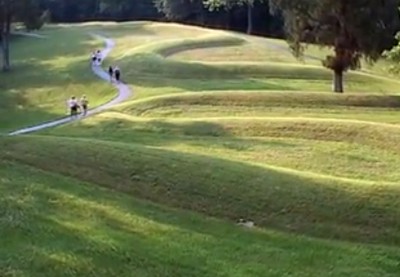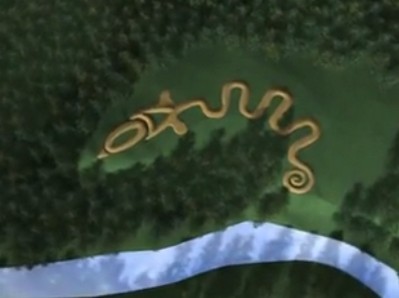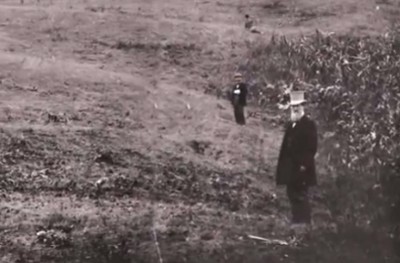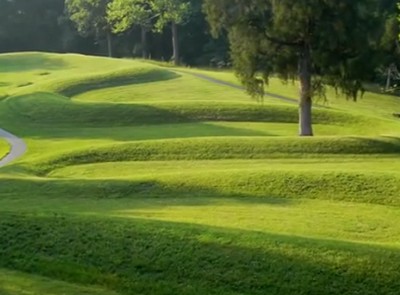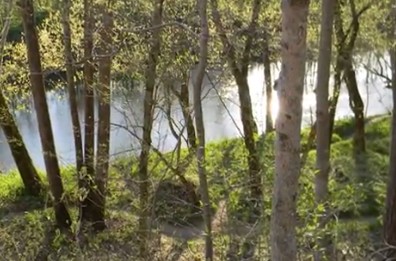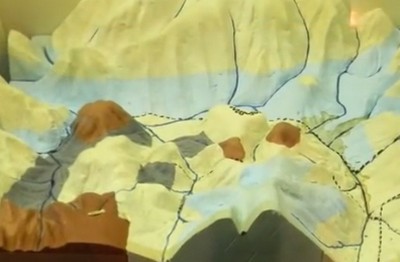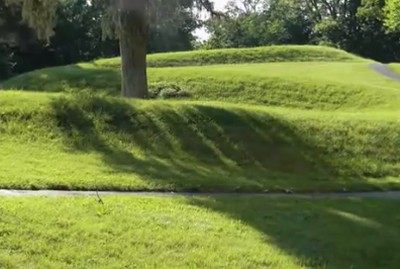
Serpent Mound
 ABOUT THE SITE
ABOUT THE SITE
Along the drive from Hillsboro to Serpent Mound State Memorial, the leading edge of the Appalachian Plateau will be prominent, bringing fundamental changes in the geology, ecology, flora, and fauna. Many of Ancient Ohio’s greatest earthen monuments are clustered along this ecological seam, where the abundance of multiple landscapes could be combined and celebrated. The change in scenery is most welcome, and the rolling hills and narrow valleys offer wonderful vistas.
Ohio’s famous serpent effigy is best visited early or late in the day, when shadows are deep. Site interpretation is much enhanced by the small museum, and by the old iron tower allowing visitors to get an overhead view of the sprawling creature. Most beautiful are the snake’s spiraling tail, the 3 main coils (which some claim offer astronomical alignments), and the head (or egg, or eye, or the sun) which faces the summer solstice sunset during annual celebrations.
The quarter-mile-long snake occupies the saddle of a ridge, near a set of ancient burial mounds. Its earthen form seems to slither westward, its head abruptly overhanging the edge of an enormous crater. This snake has rested here for nearly 1,000 years, the solstice alignment suggesting that one of the effigy’s purposes was to mark the turning of the year so that planting and gathering and hunting could be planned. But the serpent certainly had other meanings for its builders, who were connected to the widespread “Mississippian” cultural world.
Walk the serpent’s elegant length from the spiraling tail (overlooking a steep section of the Brush Creek cliffs), along the 3 main coils and down past the head.
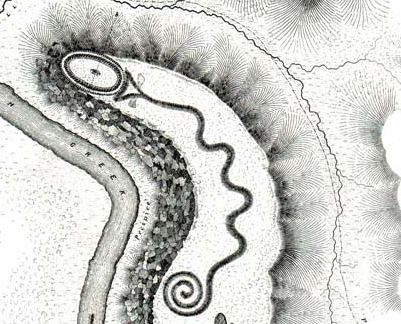
Squier and Davis recorded the Serpent in 1848, but by 1860 it was already being reduced by farming and treasure hunters.
Play video
Play video
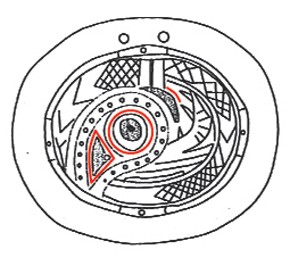
Mississippian depictions of rattlesnakes on representational abstractions match those of the effigy’s head.
 HISTORY OF THE SITE
HISTORY OF THE SITE
In 1883, Frederick Ward Putnam of Harvard University first visited the Serpent, and began a successful campaign to buy and restore it. Harvard gave the Serpent Mound to the State of Ohio in 1900, and today it remains a State Memorial open to the public, and managed by staff and volunteers of the Arc of Appalachia Preserve System. Carbon dates have shown that the Great Serpent was probably built by people of the “Fort Ancient” tradition, who followed centuries after the Hopewell. The two Adena mounds indicate this site was important for centuries before the effigy was built in about AD 1100. Indeed long before humans were here at all, the vicinity of Serpent Mound was a geological anomaly, likely the result of a primordial meteor strike or subterranean explosion. The serpent’s head looks out over the western rim of this 4-mile wide formation.
 THE BEAUTY OF THE EFFIGY
THE BEAUTY OF THE EFFIGY
Nobody is indifferent to snakes. Whether it was veneration or trepidation that inspired its builders, a creature’s beauty and power are obvious. Like all great art, it appeals to us by blending the recognizable with the abstract: its stylized precision speaks to us of “all serpents”, and more generally of “the serpentine” as an aesthetic quality. The three coils seem perfectly uniform from above, and yet as they unwind across the saddle of the hill, they gently undulate, giving the creature’s body a slithering, lifelike energy. The tail is a perfect spiral, angled gently outwards toward the cliff and valley below.
The head is so beautifully abstracted that it has baffled its archaeological interpreters for decades: is it an egg, a frog, or the sun? Is it the snake’s open mouth, its giant never-blinking eye, or its poison glands? Squier and Davis described how the builders modified the ground considerably in order to create symmetrical, ten-foot-wide surfaces along both sides of this oval figure. The refined geometry has attracted, yet baffled, all interpreters: typical analyses can get close to finding rational, or numerical formulae, including the oft-cited solar alignments, but everything is just a little bit off – perhaps too subtle for our methods today.
We know that the design was laid out all at once, with a layer of clay and ash, and reinforced with stones. The genius of its designers remains apparent: this blend of beauty, familiarity, abstraction, power, precision, and mystery, make Ohio’s Serpent Mound one of the great, iconic images for all of human antiquity.
Play video
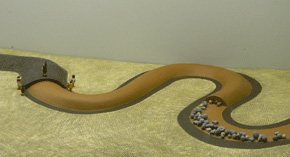
A model in the museum shows how the body of the serpent was constructed over a stone-reinforced clay surface.
 THE RIVER TRAIL
THE RIVER TRAIL
The serpent lies across a dramatic bluff. Both the head and the tail stand atop steep cliffs. Below winds Ohio Brush Creek, through the wide bottom of an ancient crater. On either side of the snake’s body, trails lead down through the forest to the riverbank. From down here, especially in the winter, the undulating shape of the bluff is visible: most prominent is this sharp, head-like formation, directly beneath the serpent’s head.
The serpent’s builders may have understood, from generations of their ancestors, that this unusual formation was already charged with the spiritual powers of serpents: that a giant snake was already embodied in the cliff forms, or slithering out of them.
 THE CRYPTO-EXPLOSION CRATER
THE CRYPTO-EXPLOSION CRATER
The valley beneath the effigy is really the western rim of a mysterious, four-mile-wide, circular crater – the eroded remains of a huge, catastrophic event geologists call “The Serpent Mound Disturbance.” About 300 million years ago, either an asteroid collision or an underground explosion blew apart more than seven cubic miles of rock. The central area was uplifted more than 1000 feet, while an outer rim dropped more than 400 feet.
What we see today results from eons of erosion, although the shattered fragments of the “Central Uplift” remain among the hills above Serpent Mound. The distant ridge tops, visible from the overlooks, stand high today because they are the much harder Ordovician bedrock that was offset by the event.
The strange geology of this spot was first noticed in modern times by Dr. John Locke of Cincinnati, who named it “Sunken Mountain” in 1838. Yet, it’s not hard to imagine that the ancient effigy builders could have recognized the unusual land forms. The serpent looks out from the edge of the Central Uplift zone.
Play video
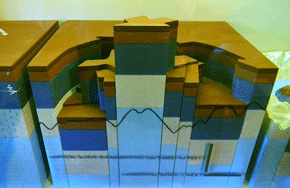
A model in the Serpent Mound Museum shows the scope of the geological disturbance underneath the effigy.
 THE MYSTERIES OF THE SERPENT
THE MYSTERIES OF THE SERPENT
From the diversity of its modern visitors, it is clear that Serpent Mound means many things to many people, yet it is little understood by archaeologists today. Questions persist about its date, its builders, and its meanings. Indian stories also vary widely: some even consider it an evil place! Arc Director Nancy Stranahan ponders this sense of mystery:
Serpent Mound is truly a powerful sacred site. I actually feel very humble trying to give voice to it, but I can tell you how it affects me. A serpent is the symbol of mystery, we don’t understand it, we know almost nothing about it. When we interpret it, we mostly tell what we don’t know. In that, I think, lies its power. We feel we know so much, and yet we mostly live in an unknown universe, and I think Serpent Mound is that gateway to remembering that we don’t really know anything. What we know is a particle or grain of sand on a beach.
Even for scholars of the site, its meanings are uncertain: It may be the “Horned Serpent” of Native American legend, perhaps in the act of swallowing the sun, in an eclipse. Built around 1066, it may be related to the “blazing serpent in the sky” that we call “Halley’s Comet” – its brightest known appearance was that year.
The iconography resembles Mississippian serpents from the same time period, found on artworks from among the urban cultures farther west. The Great Serpent, through its fame, has been opened up to many interpretations, for many people, groups, and traditions. A visit during the sunset celebrations on any June 21 tells the story: Indians from many tribes and groups, new-age mystics, earthworks enthusiasts, among others, together have many ideas about what makes this place sacred, somehow spiritually loaded.
Play video
Native Americans and many others gather for the annual celebration of the summer solstice sunset.
Play video
A Seneca-Cayuga artist explains meanings of feathers, thought by Mississippian era people to allow the Horned Serpent to fly: it was also called the “Sky Snake.”
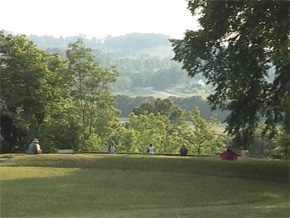
Native Americans and many others gather for the annual celebration of the summer solstice sunset.
 THE SERPENT OF EDEN
THE SERPENT OF EDEN
So recognizable was the figure of the snake, that some early visitors “knew instantly” that they could explain exactly what the Serpent Mound was about, conforming it to their own specific cultural traditions. Dr. Brad Lepper offers a prime example:
The epitome of that is the Reverend Landen West, who right around 1900, saw the serpent, this magnificent serpent, with what he thought was something in the serpent’s jaws, and he said, “This isn’t just any serpent. This is the serpent of the Garden of Eden with the apple in its mouth, and this was built by God to mark the location of Eden.” Now Adams County is a beautiful, beautiful natural environment, but I think the notion that it’s the Garden of Eden is telling us a lot more of what was on the Reverend West’s mind, than what was in the mind of the people who built it originally.

